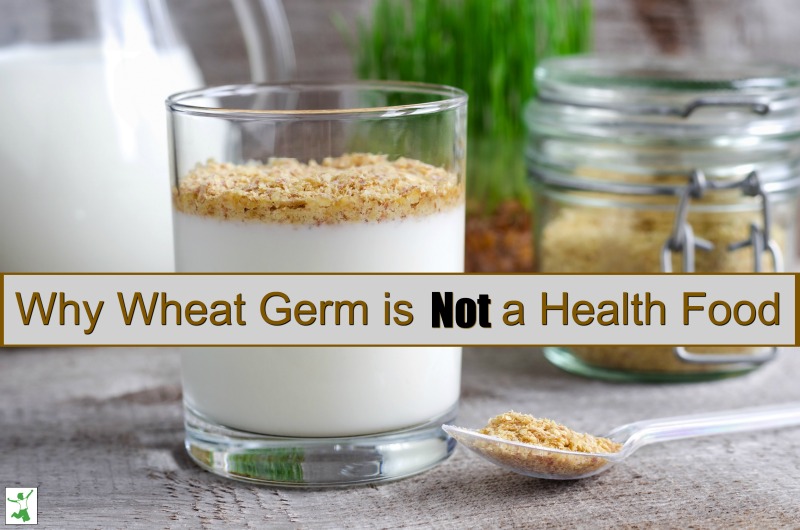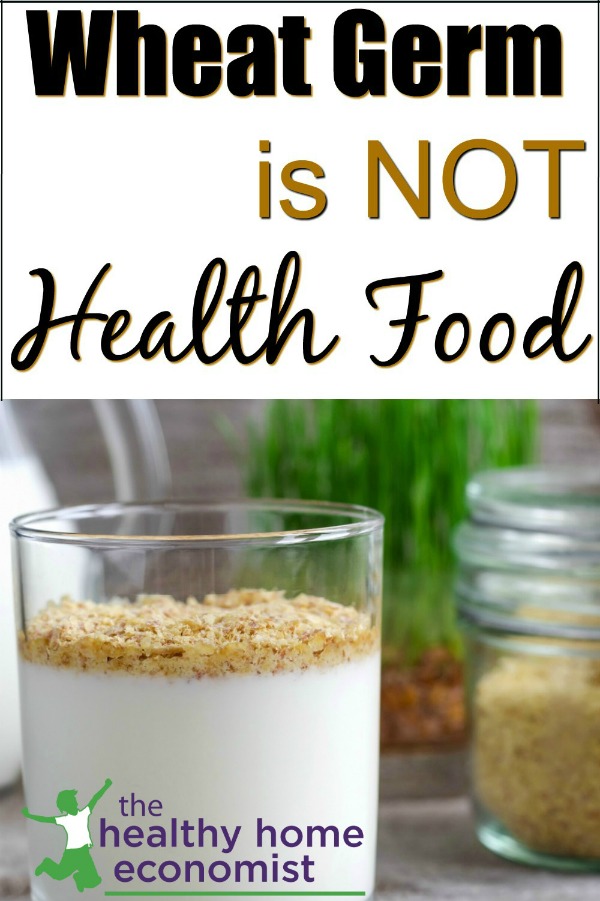Modern dietary dogma considers wheat germ to be a nutritious addition to the diet. However, there are three important reasons why savvy consumers do their best to avoid this modern-day health food even if organically grown.
Wheat germ got its start in the modern diet around the time that the refining of grains gained popularity.
With the endosperm stripped away for making white flour, the bran and the germ were left as waste products that needed a market.
The best way to sell any food to Americans is to market it as healthy, so that’s exactly what grain producers did. This approach proved to be a highly effective strategy.
Since the germ portion of wheat is a good source of natural vitamin E, folate, several minerals including phosphorus, zinc, and magnesium, and essential fatty acids, at first glance, such claims seem justified. (1)
However, a thorough examination of exactly what wheat germ is and production methods to manufacture it leads a critical thinker to the conclusion that avoiding this modern-day health food is the best approach.
Wheat Germ is Not a Whole Food
The first thing to realize about wheat germ is that it is a fractionated food. This means that the germ, which represents a very small part of each wheat kernel, is physically separated from the rest of the grain.
Such a violent process requires a factory to accomplish. This isn’t something you can easily perform in your home kitchen!
In other words, wheat germ is NOT a whole food.
It’s actually quite amusing to see the list of wheat germ uses suggested by manufacturers. The most common recommendation is to replace up to 1/2 cup of flour in a baking recipe with it! (2)
Doesn’t this seem a bit ridiculous…strip the germ away from the wheat kernel, grind it up, sell it to you (for a premium) in a jar to add back to your baking recipes?
Wouldn’t it be far more economical, healthy, and just plain smart to just use whole grain flour, to begin with, that contains the intact, unfractionated germ?
In short, wheat germ has no business being included anywhere in a whole-food-based diet even if organically certified.
Wheat Germ Oil Fatty Acid Profile
Most people don’t think of cereal grains as a source of fat, but they most definitely are. The germ of cereal grains contains this macronutrient.
Wheat germ oil has a fatty acid profile that is about 64% polyunsaturated. About 55% of wheat germ oil is omega-6 fats and about 7% is omega-3. (3, 4)
These fats are very delicate and need to be cold-pressed, refrigerated and sealed in airtight dark bottles. Otherwise, they are highly prone to rancidity.
When you separate the germ of the wheat from the bran and endosperm, you are exposing the delicate wheat germ oil to light and air which hastens the production of free radicals as the oil quickly goes rancid.
Note that organic wheat germ oil is going to go rancid just as fast as conventional.
Thus, the second important reason to avoid wheat germ is because it is a highly rancid, free radical-loaded product.
Thanks but no thanks!
Difficult to Digest
According to the Weston A. Price Foundation, wheat germ is very difficult to digest.
This stems from the fact the germ is not prepared in a traditional manner for optimum digestibility and nutrient absorption. This means that it was not soaked, sprouted or sour leavened (sourdough) first. (5)
While wheat germ itself may contain a plethora of nutrients, if your body can’t metabolize and absorb those nutrients, eating them is a worthless addition of empty calories to the diet.
Another way wheat germ harms digestion is the likelihood that it contains glyphosate residue from the off label use of Roundup for desiccation of wheat crops before harvest. Not all farmers do this, of course, but enough do that consuming anything conventional-wheat related poses a risk.
Glyphosate is known to harm beneficial microbes in the gut, paving the way for the development of autoimmune disorders slowly over time.
Fermented Wheat Germ Extract
Perhaps you’ve heard of fermented wheat germ extract (FWGE).
It was invented by Hungarian biochemist Mate Hidvégi in the early 1990s.
Despite the name, this product is not a traditional food.
FWGE is marketed as a dietary supplement for cancer patients under the brand name Avé® in the United States. It is manufactured as Avemar® in Hungary.
The research suggested that FWGE may have some immune system boosting effects for those with cancer, rheumatoid arthritis or systemic lupus. However, the evidence to date is incredibly weak at best. (6)
Healthy Substitutes
Hopefully, by this point, you’ve realized that wheat germ is not a health food and should never appear on your shopping list.
If you enjoy the texture that wheat germ imparts to baked goods, yogurt, casseroles and the like, here are a few healthy alternatives to use instead.
- Homemade breadcrumbs. Made from whole grain sprouted or authentic sourdough bread (such as this brand), DIY breadcrumbs are very easy to make and will provide the same texture as wheat germ with much better digestibility and without the rancidity.
- Unfortified nutritional yeast. This is an excellent alternative to wheat germ for stirring into yogurt and smoothies.
- Ground seeds. I suggest a coffee/herb grinder to process sprouted seeds into coarse flour to add to meatloaf, casseroles or baked goods for added texture and nutrition. Note that I do not recommend ground flax meal as it is too high in estrogens for our modern pseudo-estrogen inundated lifestyle.

References
(1) Cereal Germ
(2) What is Wheat Germ
(3) Wheat Germ Oil
(4) Fatty Acid Composition of Wheat Germ Oil
(5) Grains, Nuts, Seeds, and Beans
(6) Fermented Wheat Germ Extract








I have used wheat germ since childhood and have found it a beneficial suppplement.
“The missing link may have been found later, the story beginning with my riding a horse in Jamaica fifteen years ago with a gentleman from Illinois. While I enjoyed my sumptuous breakfast he at an odd-looking concoction, a mixture of yeast and wheat germ. He ate it, he said, becasue he used to have several grave colds every year, but since he had been eating this mixture he had had none. Having myself suffered from colds a great deal, I started to breakfast on wheat germ too, and since then I have had no colds either. Earlier, I had always been the first to pick up any cold, and had almost died twice of pneumonia. Now I look at other people with dripping noses and think “You should eat wheat germ and take ascorbic acid.”
Dr. Albert Szent-Gyorgyi (Nobel prize, discoverer of vit. C)
I recall this is from The Living State (1972). But, was wheat germ different then, vs today ? Yes ! The stuff in the stores today is all “toasted” and any good oils chemist knows, that alters the structure of the tocotrienols and all the other wonderful stuff in the germ. !
I’m not a doctor, scientist, etc, but have had many ill effects due to these and others that change or try to improve upon God’s creation. Born with severe Asthma, bone pain, growing pain, with stunted growth, poor vision, kidney problems, etc etc etc. Also have Celiac disease, which makes these problems far worse.
Again, I’m not a professional, but one doesn’t have to be to know from 63 yrs of poor health, that the poison they unload on the public should be banned, and many should serve jail time for enabling.
I totally agree about this wheat germ, a doctor put my grandmother on this garbage, which no doub shortened her life by several yrs. She no doubt had Celiac also, thought this diagnoses was unheard of yrs ago.
All the points you mention are valid, yet my experience of eating wheat germ is amazing! After the 2008 financial crisis I was forced to live on my savings. 3 years later I was broke and had to survive on wild greens on my land. My health collapsed and at 64 my body looked and acted like I was 90!!!! I dug out my old Adelle Davis books and I followed her advice on increasing protein when in a poverty stricken period of life.
I ate oats with wheat germ and ground up orange peel from oranges stolen from my neighbour’s land plus a big lump of butter. (I am gluten and dairy intolerant so it seems counterbeneficial.
After three months I noticed that 3 lifelong lumps on my upper back were gone! Shocked I inspected the rest of my body and saw other changes…..my skin was more “juicy” and my treetrunk calves suddenly had a shape. Then at the supermarket, I bumped into an old aquaintance who months previous had passed me in the street not recognising the “old lady”. This time she asked me of I had had a face lift as I looked so young! When I told her my story she immediately ran to the aisle to brab some wheat germ. Some months later my body had the shape of a young athlete! Beautiful rippling muscles which I had NEVER had before. I nearly walked into the shop windows admiring my reflection.
I am now 71 and back on my feet financially so my diet is optimal plus I take supplements and my wheat germ which costs only €1.49 for a kilo bag. I feel and look like I am 50! So despite it being a fractionated processed food, it is much better than handfuls of medications like all the age-sakes around me gulp down every day.
Thanks for your article which confirms my own thoughts yet somehow I have proof that despite logic, logical deductions can sometimes be misleading.
Cheers from Portugal
Amelia
i am so glad you are doing better, both financially and medically. your story was the exact catalyst needed to try wheat germ. i am on day 3 of eating wheat germ, with hopes i will see an improvement by next year in my own well being.
thank you very much for assisting me in my own personal journey.
Most wheat now is hybridized and has had genes removed which is one reason it is not the “staff of life” anymore but rather a source of intestinal trouble, sickness and debility. Added to that, glyphosates are used in growing it which is a chelator, similar to toilet bowl cleaner, that strips away micro minerals which are the key to all vitamin and mineral assimilation by the body. Modern wheats, chemically grown are rightly called a “staff of death.” Wheat germ from these modern wheats is where the concentrated oils of the grain are and where the most potent source of these toxins will be found. Wheat germ on the other hand from ancient and heirloom wheats grown in naturally clean soils free from pesticides, chemical fertilizers etc. is full of life-giving properties. So, which wheat-germ or wheat kernel, grown where?
Interesting article. In “Nourishing Traditions,” Sally Fallon recommends wheat-germ oil. Do you disagree with her recommendation? If so, what would be a better source for vitamin E?
Thank you for talking about this despite most of the sources that say about the benefits of this product. I was always bewildered by such assurances that all problems will disappear as soon as you start taking this product for food. And very rarely any of the serious doctors also confirm this information. Therefore, I probably did not really believe this information. So thank you for confirming my fears and telling the truth without looking back at all sources of other opinions. Now I understand how right I was.